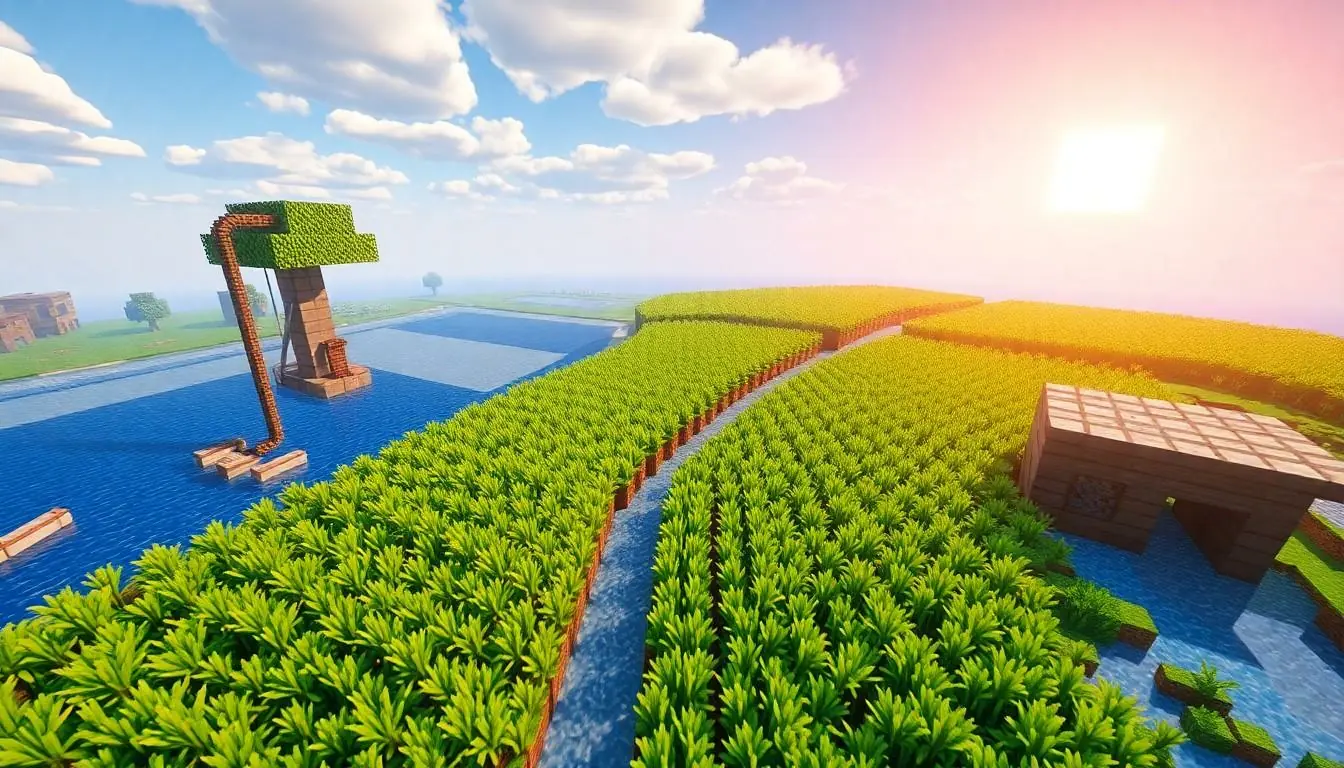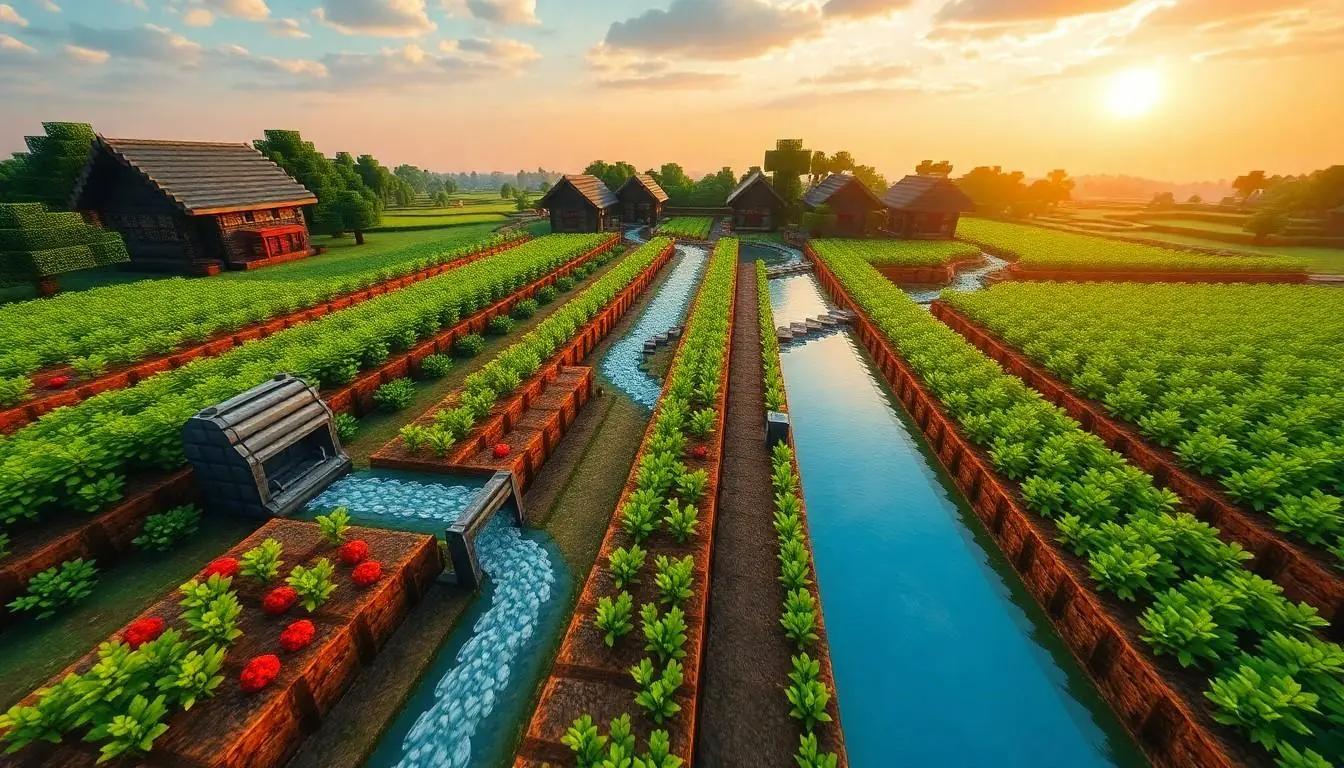In the pixelated world of Minecraft, farming isn’t just a way to feed your character; it’s an art form. Imagine a farm that runs itself while you’re off exploring caves or battling creepers. That’s right—automatic farms are the secret weapon every Minecrafter needs to level up their game. With a little redstone magic, players can transform their plots into efficient, self-sustaining operations that churn out resources faster than you can say “blocky bread.”
Table of Contents
ToggleOverview Of Minecraft Automatic Farms
Automatic farms in Minecraft streamline resource gathering, transforming the player experience. Players benefit significantly from these farms as they provide uninterrupted production of essential materials. Creating an automatic farm relies heavily on redstone components, which function as the backbone of automation.
Various types of automatic farms exist, each serving unique purposes. Crop farms yield essential food items, while animal farms produce meat and other resources. Additionally, ore farms provide valuable minerals essential for crafting and survival.
For example, a simple wheat farm utilizes pistons and observers to harvest crops automatically when they reach maturity. This system reduces manual labor and increases efficiency, allowing players to focus on exploration or combat.
Farm designs can range from basic setups to complex mechanisms with multiple levels. More advanced farms may include water flow systems, enabling faster item collection. Utilizing a mix of redstone machines, players can create vastly productive farms tailored to their specific needs.
Automatic farms save time and effort, ultimately enhancing gameplay enjoyment. Players gain significant advantages by incorporating these farms into their survival strategies. As they explore the vast Minecraft world, automatic farms provide a steady stream of resources with minimal input, contributing to a more satisfying gaming experience.
Benefits Of Using Automatic Farms
Automatic farms significantly enhance gameplay in Minecraft by streamlining resource collection. Players benefit from both increased efficiency and improved resource management.
Increased Efficiency
Efficient farming becomes a reality with automatic systems in place. Players spend less time harvesting crops or gathering resources manually, allowing them to focus on exploration or combat. Numerous designs utilize redstone components like pistons and hoppers, creating seamless workflows. A well-designed farm can produce hundreds of resources per hour. Utilizing water channels further accelerates item collection and reduces clutter. Automating the repetitive tasks associated with farming transforms the gaming experience, leading to higher productivity without the grind.
Resource Management
Managing resources efficiently becomes straightforward with automatic farms. Players can stockpile essential materials without sacrificing time or effort. Automatic farms ensure a steady supply of food, building materials, or rare items needed for crafting. Through these farms, players achieve sustainability, as they can continuously gather resources while pursuing other objectives. Effective use of storage systems integrates well, allowing automatic sorting and retrieval of items. Players enjoy organized storage, reducing the chaos typically associated with resource management in Minecraft. Emphasizing organization and consistent output, automatic farms significantly simplify gameplay.
Types Of Minecraft Automatic Farms
Automatic farms in Minecraft fall into several categories, catering to different resource needs and strategies.
Crop Farms
Crop farms efficiently produce food items like wheat, carrots, and potatoes. Players use redstone components like pistons and observers to automate the planting and harvesting processes. Water flow enhances collection, moving items to hoppers for storage. These farms significantly reduce manual labor, allowing players to focus on exploration, crafting, or combat. A well-designed crop farm can yield hundreds of food items per hour, ensuring a steady supply of resources for survival or trading.
Animal Farms
Animal farms specialize in breeding and harvesting livestock, including cows, pigs, and chickens. By utilizing fences and gates, players create enclosures for animals. Redstone mechanisms like dispensers can automatically feed them for faster growth. Egg, milk, and meat production increases efficiency in resource gathering. With proper design, an animal farm provides a continuous supply of necessary food items, contributing to player sustainability in the game. These farms not only offer food but also valuable materials like leather and feathers.
Resource Farms
Resource farms focus on gathering valuable minerals and materials, such as ore and nether resources. Players set up automated systems that utilize dedicated mobs, such as golems, to farm materials like iron and gold. Additionally, mob grinders can produce drops from hostile entities, maximizing resource collection. These farms handle large quantities, supplying players with essential crafting components. Efficiently designed resource farms greatly enhance a player’s ability to progress in the game by ensuring consistent access to necessary materials.
How To Build A Basic Automatic Farm
Building a basic automatic farm in Minecraft requires specific materials and a straightforward process. Automatic farms increase productivity, allowing players to gather resources without constant supervision.
Required Materials
- Pistons: Four pistons facilitate the mechanization of the farm.
- Observers: Two observers detect crop growth and trigger pistons.
- Redstone Dust: Several pieces of redstone dust connect the components for efficient signaling.
- Water Buckets: A water source aids in crop growth and helps collect harvested items.
- Seeds: Specific crops like wheat, carrots, or potatoes yield food items.
- Building Blocks: Any solid blocks provide a framework for your farm.
Gathering these materials ensures getting started quickly and effectively.
Step-By-Step Guide
- Set up a 9×9 plot of tilled soil for planting crops.
- Place water in the center block to hydrate the surrounding soil.
- Arrange pistons on one side of the plot, facing towards the crops.
- Position observers behind the crops, ensuring they face the planted seeds.
- Connect the observers to the pistons using redstone dust.
- Plant your chosen seeds in the tilled soil.
- Activate the system by stepping on a button or using a lever to start the automation.
Following this guide creates a functional automatic farm, enhancing Minecraft gameplay and resource production.
Advanced Automatic Farm Designs
Advanced automatic farms leverage intricate designs to maximize efficiency. Players use redstone technology to create complex systems that automate various farming tasks.
Redstone Mechanisms
Redstone mechanisms play a crucial role in automatic farm designs. These components include pistons, observers, and redstone dust, forming the backbone of automation. Combining these elements leads to the creation of machines that can harvest crops and gather resources without player intervention. A simple system, for instance, employs observers to detect crop growth and trigger pistons for harvesting. With efficient setups, these farms can yield large quantities of items per hour, providing players with essential resources quickly. Optimizing layouts and minimizing delays enhances overall productivity, allowing continuous resource flow.
Integration With Other Systems
Integration with other systems elevates the functionality of automatic farms. Connecting storage systems directly to farms streamlines item management effectively. Utilizing hoppers allows for efficient transfer of harvested goods into chests. Players alongside redstone creations can implement water streams to transport items automatically, further improving collection efficiency. Automated breeding systems can be combined with animal farms, enabling consistent production of meat and materials with minimal effort. Coordinating multiple systems creates a seamless operation, making it easier for players to maintain resource stockpiles while focusing on exploration or combat.
Conclusion
Automatic farms in Minecraft revolutionize the farming experience by merging creativity with efficiency. Players benefit from reduced manual labor and a steady stream of resources, allowing them to focus on other aspects of gameplay. The integration of redstone technology elevates these farms, enabling seamless operations that cater to individual needs.
Whether it’s cultivating crops, breeding animals, or mining resources, automatic farms provide a sustainable solution for resource management. With the right designs and setups, players can unlock new levels of productivity and enjoyment in their gaming journey. Embracing automatic farming not only enhances survival but also transforms Minecraft into a more immersive and rewarding experience.





